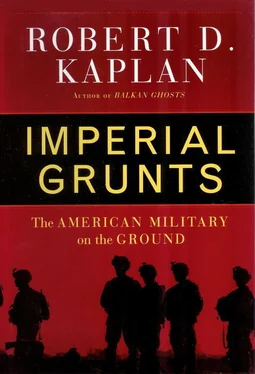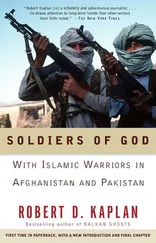SOUTHCOM’s identity was further defined by a feeling of inferiority. With Europe the principal Cold War battleground, and Asia the secondary front because of the threat posed by “Red” China and North Korea, the American military in Latin America had for decades been given short shrift, even as it had a vast area to defend. The answer to this predicament was aggressive intelligence operations and Special Forces’ training of local armies, combined with coercive diplomacy.
The results were not always pretty: witness the murder of thousands of innocent civilians in the aftermath of the 1973 coup against Salvador Allende in Chile. Yet for a relatively small investment in money and manpower, the U.S. neutralized an aggressive Soviet and Cuban campaign at its back door, helping to pave the way for the democratic transitions and market liberalizations of the 1980s and 1990s. In 1967 in Bolivia, Special Forces helped hunt down and kill the hemispheric agitator Ernesto “Che” Guevara. [12] SOUTHCOM provided a fifteen-man Special Forces Mobile Training Team to train a Bolivian Ranger battalion, which killed Guevara. Guevara had hoped that the U.S. would respond with a massive gringo intervention; in fact, Washington’s response was measured. Guevara’s company made the additional mistake of trying to recruit native Bolivian Indians whose Quechua and Aymara languages they didn’t speak. See John D. Waghelstein, “Ruminations of a Pachyderm or What I Learned in the Counter-insurgency Business,” Small Wars and Insurgencies (London: Cass, Winter 1994), p. 362.
In the 1980s in El Salvador, 55 Special Forces trainers accomplished arguably more than 550,000 troops in Vietnam: teaching the Salvadoran military to slow down a communist insurgency, even as it transformed itself from a 12,000-man, ill-disciplined constabulary force to a more professional 60,000-man army. [13] The Special Forces operation in El Salvador was certainly not a complete success; nor were many aspects of the Vietnam War a failure. Moreover, the congressionally imposed limit of 55 SF trainers at any one time—a reflection of the Vietnam syndrome—was not always adhered to; in fact, the real number on the ground was often higher. Still, it was an exceedingly small number. The U.S. approach to El Salvador showed that as much help as the U.S. gives a besieged ally in a small war, ultimately, military and humanitarian assistance must operate under a reasonably strict ceiling, so that the war remains the ally’s to win or lose.
El Salvador showed that you didn’t need many people to fight these small wars, but the ones you deployed should be the best. 8
“Economy of Force” was what Maj. Gen. Geoffrey C. Lambert at Fort Bragg and SOUTHCOM hands in Miami called the strategy of the Cold War decades—their way of talking about the right hinge. Actually, Economy of Force was a strategy practiced by all the great empires of antiquity, which had prevailing but not unlimited amounts of military power, so that necessity required them to be both light and lethal, leading to a reliance on mobile strike forces and client states, which was particularly the case with Rome. 9
In Latin America, an Economy of Force strategy had produced friendly regimes that in almost every case were better than what the Cubans and Russians had in mind. Even in Chile, despite the human rights iniquities of dictator Augusto Pinochet following Allende’s overthrow, the military regime there subsequently lowered infant mortality from 79 to 11 per 1,000 births, and reduced the poverty rate from 30 percent of the population to 11 percent. 10Such melding of the political reality south of the border did not run the risk of quagmires, for throughout the Cold War there were relatively few official Americans on the ground in any one Latin American country.
SOUTHCOM’s Economy of Force concept now offered a beautiful logic for the seemingly intractable world of the turn of the twenty-first century, in which everyone (humanitarian interventionists included) admitted that nation-building, whether it was in Bosnia, Afghanistan, Iraq, or Colombia, was fraught with danger, difficulty, uncertainty, and great expense.
Don’t try to fix the whole society. Rather, identify a few key pivotal elements in it, and try to fix them. For example, because a national army is essentially unreformable without wholesale social and cultural change, work to improve only its elite units, using men from America’s own military elite as trainers. That had been the motor for change in El Salvador, where political violence per month was reduced from 610 murders in 1980 to 23 in 1987. 11It was the strategy in Colombia, too.
———
The exterior of the American Embassy in Bogotá, Colombia, was a replica of the one I had seen in Sana’a, Yemen. Both were “Inman buildings,” a reference to Adm. Bobby Ray Inman, who in 1985 chaired an advisory panel that set tougher security standards for U.S. embassies. There were the fleet of armored cars whose drivers always altered their routes, the bomb-blast walls, the hundred-foot setbacks, sliding electronic gates, and active vehicle restraints (AVRs), also known as Delta barriers, that popped up from below the ground.
The Bogotá embassy compound was a world of acronyms, a particular feature of America’s entire national security community at the dawn of the twenty-first century. Acronyms formed the private language that only the initiated understood, like the Latin and Greek once spoken by the upper echelons of the British Empire. Inside the embassy was the NAS (narcotics affairs section), which ran the CD (counter-drug) program. Adjacent to the main building, in a one-level prefabricated unit, made of two sheets of aluminum separated by foam, was the TOC, or tactical operations center, for the 3rd Battalion of the 7th Special Forces Group. The TOC was also known as the FOB, the forward operating base for the 3rd Battalion. [14] For diplomatic reasons, it was politically unacceptable for SOUTHCOM to have a forward operating base inside Colombia. Thus, it was technically a battalion headquarters and not an FOB, though that’s what everyone called it.
The 3rd Battalion, like all Special Forces battalions, was divided into
three companies that were in turn divided into six twelve-man detachments, many of which were strewn across Colombia. The FOB was manned by one of these detachments, ODA-773: Operational Detachment Alpha-773. The Alpha signified that this was a front-line SF team, even if it currently functioned in a support role.
In a corner office of the FOB sat the 3rd Battalion’s commander, Lt. Col. Kevin A. “Duke” Christie, the effective leader of all Green Berets in Colombia. Like Coast Guard Capt. Innes in Yemen, he was a New York City fireman’s kid, though from Queens rather than Brooklyn. Duke Christie had joined Army ROTC at Florida State University. The first time he was shot at was by urban guerrillas in Lima, Peru, in the 1980s. He served afterwards in Bosnia and Pakistan, trained paratroopers in Kenya, spoke French and German, and was forgetting his Russian, even as his Spanish was coming along. Gangly and muscular, with sharp features and short, corn-colored hair combed upward in 1950s style, Duke Christie was one of those personable guys you could begin your first conversation with in mid-sentence, though when I first met him at SOUTHCOM headquarters in Miami he had been somewhat subdued. One of the best officers in his command, Capt. Adam Kocheran, a West Point graduate about to enter medical school, with a pregnant wife, had just been killed by a claymore mine in a training exercise in Puerto Rico.
The battle update brief for Friday, February 7, 2003, prepared for Duke by his staff, began at 8 a.m. at the FOB in Bogotá. Around a three-sided arrangement of Formica tables with fans whirring sat Maj. Albert Quiros, Capts. Bill Pittman and Luciano Gonzales, Chief Warrant Officer III Pat Gleason, and other officers. All were in BDUs (battle dress utilities, green camouflage uniforms for U.S. troops in the tropics, tan for those in the desert Middle East). The first subject was a “Nairobi scenario,” a reference to the 1998 al-Qaeda bombing of the American embassies in Nairobi, Kenya, and Dar es Salaam, Tanzania.
Читать дальше












